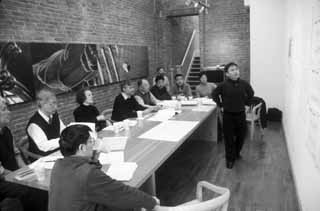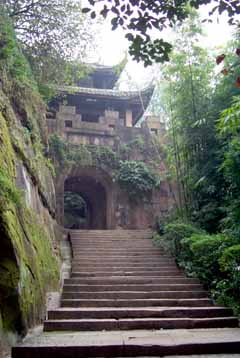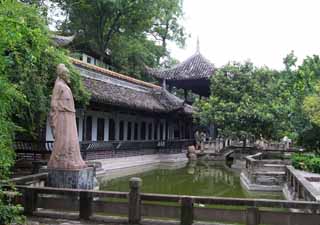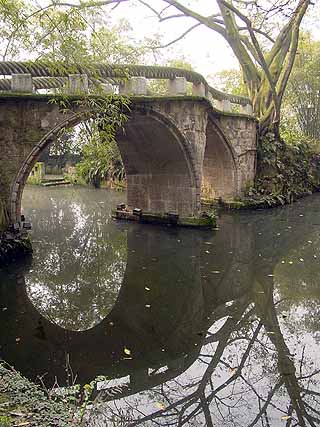
Surveys
DJC.COM
November 10, 2005
Design dialogues cultivate Seattle's Chinese garden
Jones & Jones

Photo by Cory Parker/Jones & Jones
Chongqing Municipal Parks Bureau designers regularly meet with the Jones & Jones team to discuss the design for the Seattle Chinese Garden.
|
The design and construction of public infrastructure requires complex dialogue between the architect, contractor and owner. This dialogue is increasingly cross-cultural as relationships with international designers, global corporations and other governments increase. No other project in Seattle relies so heavily on a cross-cultural dialogue than the Seattle Chinese Garden.
For the past two decades, the city and the Seattle Chinese Garden Society have developed a close relationship with our sister city, Chongqing in the Sichuan region of China. The concept of a Chinese garden built in Seattle to celebrate this relationship has steadily grown over the years, and finally came to reality with a groundbreaking last August.
The Garden Society has worked closely with Chongqing officials to select a site on the northernmost portion of South Seattle Community College's campus, choose a design team and raise funds for the first construction phase. Perhaps more importantly, the Garden Society has kept a dialogue going with designers from Chongqing's Municipal Parks Bureau on the elements and aesthetics of a traditional Sichuan garden.

Photo courtesy Chongqing Municipal Parks Bureau
Traditional gardens from the mountainous Sichuan region are more naturalistic than the more ubiquitous Suzhou-style gardens.
|
Jones & Jones Architects and Landscape Architects was hired by the Garden Society to oversee the Seattle design team and refine the master plan generated by Chongqing designers to comply with local code, improve its constructability and preserve the traditional elements of Sichuan gardens. There is very little precedent for this.
Other Chinese gardens have been built in the United States in Portland and New York City, and in Canada in Vancouver and Montreal, but these gardens are Suzhou-style, a much different type than the more naturalistic, traditional gardens near Chongqing.
The Seattle Chinese Garden will be the first Sichuan-style garden built outside of China.
In order to learn more about Sichuan gardens, several formal and informal delegations have journeyed to Sichuan. Architects have studied the clay-tile roofs and intricate carved doors while volunteers have documented many of the plants grown in traditional gardens.
Each delegation brings back a more complete picture of traditional gardens and adds to the on-going design dialogue. Through these trips and our on-going relationships with Chongqing's Bureau of Parks and Greenery, we have found three major differences in how our two cities approach the design and implementation of parks and gardens.
Funding

Photo courtesy Chongqing Municipal Parks Bureau
Traditional Chinese gardens combine rock, water, plants and buildings to reinforce cultural associations from literature, painting and architecture. |
In China, and especially in a rapidly developing "new" city like Chongqing, public gardens are initiated, funded and run by the government. In Seattle, the Chinese Garden was initiated by the city, handed over to a nonprofit group, funded by private and public donors such as Boeing and the city, and will eventually be operated using funds from admissions, gift concessions and facility rental fees.
What does this have to do with design? To fund the continuing operations of the garden, the Garden Society needs a large banquet hall for weddings and other events, a kitchen for catering, offices, a gift shop and meeting rooms. These are not traditional components of a Sichuan garden.
When the Chongqing designers unveiled their first master plan, none of the above facilities were included. They wrestled with how to adopt the Garden Society's program while maintaining an authentic garden. An elegant solution evolved as the garden was split into two parts: A separate administrative complex and Gathering Together Hall next to the garden's entry court built in the Chongqing domestic style, and the traditional garden with formal and ornate pavilions and walkways.
By dividing the site into two parts, the Chongqing designers and the local team were able to maintain the garden's authenticity. The result, according to Kathy Scanlan, the Garden Society's executive director, is "a design that will allow the garden to be largely supported by income from admissions, catering and store sales while remaining true to its purpose of immersing visitors in Chinese culture."
Materials and labor

Photo courtesy Chongqing Municipal Parks Bureau
This Chongqing rope bridge is characteristic of the rustic design found in the Sichuan region.
|
In China, traditional materials and craftsmen labor are inexpensive. A beautiful Sichuan wood-frame building with a clay-tile roof requires frequent maintenance to repair rotting wood and replace damaged tiles. In Seattle, with a humid climate similar to Chongqing's, it would be cost-prohibitive to use traditional materials for all of the structural elements, especially if they have a short life cycle.
Jones & Jones is working with Joe Wai Architects in Vancouver, B.C., and Magnusson Klemencic Associates in Seattle to generate innovative architectural solutions, similar to the ones used in the Dr. Sun Yat-Sen Park in Vancouver. Instead of solid wood posts for garden pavilions, we have suggested using steel beams with wood cladding. Instead of traditional clay tiles, we are considering using more durable high-fired tiles and fiberglass ornamentation.
Use of materials is also guided by our more stringent regulatory requirements, an entire sub-dialogue we have maintained with the Chinese to ensure the authenticity of the garden.
The design thought process
In the United States, design is primarily functional and constrained by regulations. The highest profile projects may be more conceptual with an overriding symbol or repetition of an idea to generate movement and emotion, but usually designers are trying to maximize the use of space while keeping it accessible, structurally sound, compliant with zoning and environmentally friendly.
Many of those considerations are important to Chongqing designers, but for traditional landscapes and buildings they start with a site's natural characteristics in the context of thousands of years of historical meaning and symbolism. An old pine tree on a site symbolizes longevity. So buildings may be sensitively sited around it to highlight the young-and-old relationship and frame views of the surrounding mountains — all while preserving the tree.
Traditional gardens have four key elements — stone, water, plants and architecture — that must be combined to enhance meaning and tell a story. Each garden element is named at the beginning of the design and again when the element is built. In between, the names change as the design changes. The name is equally important to the design as the actual wood or stone.
As designers in Seattle, we have had to learn a new way of designing that involves the Chinese meanings and symbolism. While it is tempting to get frustrated when a building that we used to call the Elegant Hall is now called the Studio of Cultivating Mountain, the more difficult immersion into a Sichuan sensibility has paid off as we implement traditional ideas.
The relationship between Seattle and Chongqing has grown and will continue to grow through the design of a garden.
Cory Parker is a landscape architect at Jones & Jones Architects and Landscape Architects. His designs reveal ecology and celebrate cultures.
Other Stories:
- How to get more floor space in high-rise condos
- Listen closely on how to find leaky pipes
- Fitting feng shui into Western architecture
- Designing a feast for the eyes
- Artists, architects find a sense of place
- Can the Northwest be energy independent again?
- Add an archaeologist to the design team
- Is Seattle ready to slim down its residential towers?
- New waterfront mandate: OK isn't good enough
- A modern way to fortify an old building
- Are you ready for a $30B quake?
- Try integrated 3-D design for better buildings
Copyright ©2009 Seattle Daily Journal and DJC.COM.
Comments? Questions? Contact us.